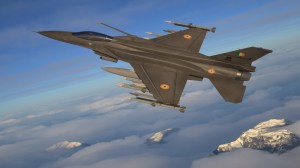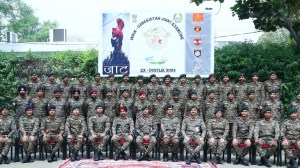By Dr AK Shah
There were a flurry of articles in the media on the first indigenous aircraft carrier of our country immediately prior to and post commissioning of INS Vikrant. She was popularly known as IAC (Indigenous Aircraft Carrier) till then. These articles touched upon the complexity of the ship, her features and capabilities, the indigenous content, the development of indigenous steel, the pontoon assisted launch and the implications on maritime security etc. There was also a mention of the employment opportunities during her construction. But there was only a passing reference to the welding technology that went into joining the steel plates to build the aircraft carrier that it actually is today. Developing the welding process indigenously was a challenge in itself. A word about these challenges will bring out the intricacies in building the steel hull of a ship using indigenous steels.
India began work on IAC sometime in 2002 with a lot of challenges to be overcome to realise the dream of make in India. Prior to this, many Indian Naval ships were either imported or built using imported steel and weld consumables (welding electrodes, flux etc). The Indian Navy tried many times to go in for indigenous development of these but small volumes prevented them from doing so. Construction of IAC provided a big opportunity to push for indigenisation as it was being designed to be a large ship which would require large volumes of steel and weld consumables. The Navy took up the challenge and got the first indigenous shipbuilding steel DMR249A manufactured in India in association with Defence Metallurgical Research Laboratory (DMRL) of Defence Research and Development Organisation (DRDO) and Steel Authority of India Limited (SAIL). Another challenge was to find a shipyard that had a dry-dock which could accommodate and launch such a large ship. No shipyard out of the Defence Public Sector Undertakings (DPSUs) was capable of handling such a big ship. So Cochin Shipyard Ltd (CSL) which was constructing merchant ships only till then was contracted as it had the dry-dock of the requisite size to handle IAC.




Read More: INS-Vikrant, First Indigenous Aircraft Carrier
In the meantime, the successful development of the shipbuilding steel at SAIL encouraged the Navy to review their policy on usage of steels for constructing all future naval ships in order to reduce a large inventory of steels for different classes of ships. Thus to put an end to its legacy of using numerous types of steels, the Navy decided to use DMR249A only for all Naval ships to be built in Indian shipyards. However, the Navy soon realised that though the steel would be ready, the variety of weld consumables required to construct the ship may not be available in adequate quantity as only one manufacturer, Mishra Dhatu Nigam Ltd (MIDHANI), was producing them that too based on imported technology. The Navy then tasked another laboratory of DRDO, Naval Materials Research Laboratory (NMRL) to develop the weld consumables and the appropriate weld technology for the indigenous shipbuilding steels.
The design and development of weld consumables and its welding technology is complicated with many constraints as compared to steel development. The conflicting properties of high strength and toughness are achieved in the steel by optimising its chemical composition, mechanical deformation during forging and rolling the steel in the form of plates and subsequent optimisation of its properties by heat treatment i.e. controlled heating and cooling cycles. In the case of weld consumables you achieve the properties by optimising the composition and limited localised control on the heating and cooling cycles after the solidification of deposited metal. The important step of mechanical deformation in steel making is not available. The limited control over the heating and cooling cycles is achieved by employing the appropriate welding technology. The welding process also alters the properties of the steel which is adjacent to the weld joint and it is termed as Heat Affected Zone (HAZ). Even the optimisation of the weld deposit composition is constrained due to the problem of galvanic corrosion in seawater, if the composition is grossly different from the steel plate. As the majority of the welding is done manually by welders, the variability of human skill becomes an issue especially when the welding is to be done in vertical or overhead positions. The use of proper welding technology, therefore, becomes critical to achieve a narrow band of tolerances for the final properties of the joint while encompassing all these constraints. This is achieved by optimising heat input during welding by controlling the welding variables within the narrow band.
Read More: Historical Day! Indian Navy gets indigenous aircraft carrier, joins niche group of countries to build its own carrier
The task involved development of different weld consumables for various welding processes such as, Manual Metal Arc Welding (MMAW), Gas Metal Arc Welding (GMAW), Flux Cored Arc Welding (FCAW) and Submerged Arc Welding (SAW) and their welding technology. The challenge was to develop multiple vendors in a very short time to meet the high demand. Another challenge was adaptation of the technology on the shop-floor of the shipyard. The defence shipyards (DPSUs) were used to welding other high strength high toughness steels of similar kind. But, CSL was not used to the controlled heat input welding required for this grade of steel. They built ships using mild steel welding where the only criterion was high productivity. However, they adapted to the challenge very fast.
The Indian weld consumables industry also rose to the occasion and took up the challenge with utmost dedication and undying enthusiasm. Employing concurrent engineering methodologies, the challenges of laboratory development, shipyard evaluation, WPS (Welding Procedure Specification) / PQR (Procedure Qualification Record) development and delivery to the shipyard after due approval of the procedures was achieved in a short duration of two years.
The spin-offs from construction of INS Vikrant have been many. The Indian industry has been exposed to new technologies, thus giving a fillip to the Make in India programme.
Author retired as Scientist G from NMRL, DRDO. He was instrumental in the development of weld consumables and technology for DMR249 steels. He is an alumnus of IIT Roorkee and National Defence College. He was the Director of two engineering colleges PIET, Panipat and THDC-IHET, Tehri post retirement for four years. He is passionate about growing vegetables using hydroponics and trains people interested in it.
Disclaimer: Views expressed are personal and do not reflect the official position or policy of Financial Express Online. Reproducing this content without permission is prohibited.





















